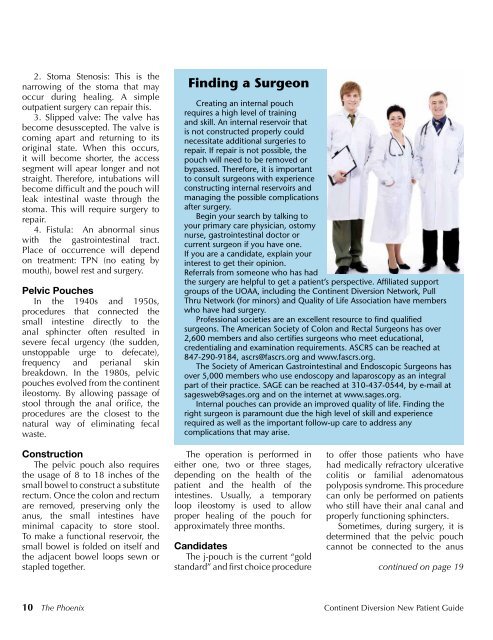Continent Diversion - United Ostomy Associations of America
Continent Diversion - United Ostomy Associations of America
Continent Diversion - United Ostomy Associations of America
You also want an ePaper? Increase the reach of your titles
YUMPU automatically turns print PDFs into web optimized ePapers that Google loves.
2. Stoma Stenosis: This is the<br />
narrowing <strong>of</strong> the stoma that may<br />
occur during healing. A simple<br />
outpatient surgery can repair this.<br />
3. Slipped valve: The valve has<br />
become desusscepted. The valve is<br />
coming apart and returning to its<br />
original state. When this occurs,<br />
it will become shorter, the access<br />
segment will apear longer and not<br />
straight. Therefore, intubations will<br />
become diffi cult and the pouch will<br />
leak intestinal waste through the<br />
stoma. This will require surgery to<br />
repair.<br />
4. Fistula: An abnormal sinus<br />
with the gastrointestinal tract.<br />
Place <strong>of</strong> occurrence will depend<br />
on treatment: TPN (no eating by<br />
mouth), bowel rest and surgery.<br />
Pelvic Pouches<br />
In the 1940s and 1950s,<br />
procedures that connected the<br />
small intestine directly to the<br />
anal sphincter <strong>of</strong>ten resulted in<br />
severe fecal urgency (the sudden,<br />
unstoppable urge to defecate),<br />
frequency and perianal skin<br />
breakdown. In the 1980s, pelvic<br />
pouches evolved from the continent<br />
ileostomy. By allowing passage <strong>of</strong><br />
stool through the anal orifi ce, the<br />
procedures are the closest to the<br />
natural way <strong>of</strong> eliminating fecal<br />
waste.<br />
Construction<br />
The pelvic pouch also requires<br />
the usage <strong>of</strong> 8 to 18 inches <strong>of</strong> the<br />
small bowel to construct a substitute<br />
rectum. Once the colon and rectum<br />
are removed, preserving only the<br />
anus, the small intestines have<br />
minimal capacity to store stool.<br />
To make a functional reservoir, the<br />
small bowel is folded on itself and<br />
the adjacent bowel loops sewn or<br />
stapled together.<br />
Finding a Surgeon<br />
Creating an internal pouch<br />
requires a high level <strong>of</strong> training<br />
and skill. An internal reservoir that<br />
is not constructed properly could<br />
necessitate additional surgeries to<br />
repair. If repair is not possible, the<br />
pouch will need to be removed or<br />
bypassed. Therefore, it is important<br />
to consult surgeons with experience<br />
constructing internal reservoirs and<br />
managing the possible complications<br />
after surgery.<br />
Begin your search by talking to<br />
your primary care physician, ostomy<br />
nurse, gastrointestinal doctor or<br />
current surgeon if you have one.<br />
If you are a candidate, explain your<br />
interest to get their opinion.<br />
Referrals from someone who has had<br />
the surgery are helpful to get a patient’s perspective. Affi liated support<br />
groups <strong>of</strong> the UOAA, including the <strong>Continent</strong> <strong>Diversion</strong> Network, Pull<br />
Thru Network (for minors) and Quality <strong>of</strong> Life Association have members<br />
who have had surgery.<br />
Pr<strong>of</strong>essional societies are an excellent resource to fi nd qualifi ed<br />
surgeons. The <strong>America</strong>n Society <strong>of</strong> Colon and Rectal Surgeons has over<br />
2,600 members and also certifi es surgeons who meet educational,<br />
credentialing and examination requirements. ASCRS can be reached at<br />
847-290-9184, ascrs@fascrs.org and www.fascrs.org.<br />
The Society <strong>of</strong> <strong>America</strong>n Gastrointestinal and Endoscopic Surgeons has<br />
over 5,000 members who use endoscopy and laparoscopy as an integral<br />
part <strong>of</strong> their practice. SAGE can be reached at 310-437-0544, by e-mail at<br />
sagesweb@sages.org and on the internet at www.sages.org.<br />
Internal pouches can provide an improved quality <strong>of</strong> life. Finding the<br />
right surgeon is paramount due the high level <strong>of</strong> skill and experience<br />
required as well as the important follow-up care to address any<br />
complications that may arise.<br />
The operation is performed in<br />
either one, two or three stages,<br />
depending on the health <strong>of</strong> the<br />
patient and the health <strong>of</strong> the<br />
intestines. Usually, a temporary<br />
loop ileostomy is used to allow<br />
proper healing <strong>of</strong> the pouch for<br />
approximately three months.<br />
Candidates<br />
The j-pouch is the current “gold<br />
standard” and fi rst choice procedure<br />
to <strong>of</strong>fer those patients who have<br />
had medically refractory ulcerative<br />
colitis or familial adenomatous<br />
polyposis syndrome. This procedure<br />
can only be performed on patients<br />
who still have their anal canal and<br />
properly functioning sphincters.<br />
Sometimes, during surgery, it is<br />
determined that the pelvic pouch<br />
cannot be connected to the anus<br />
continued on page 19<br />
10 The Phoenix <strong>Continent</strong> <strong>Diversion</strong> New Patient Guide








